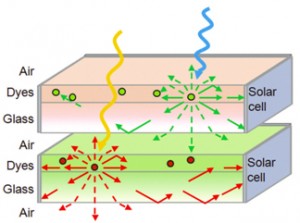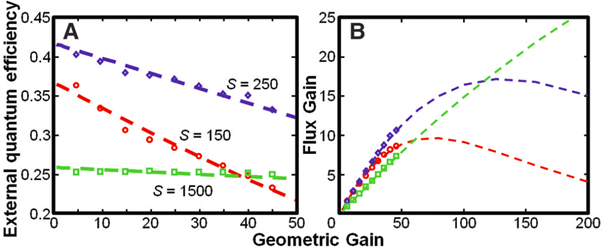Research
Organic Solar Concentrators
M.J. Currie, J.K. Mapel, T.D. Heidel, S. Goffri, M.A. Baldo
Sponsorship: U.S. Department of Energy (DE-FG02-07ER46474) and U.S. National Science Foundation (OR 5653-001.01)
Photovoltaic (PV) concentrators aim to increase the electrical power obtained from solar cells. Conventional solar concentrators track the sun to generate high optical intensities, often by using large mobile mirrors that are expensive to deploy and maintain. Solar cells at the focal point of the mirrors must be cooled, and the entire assembly wastes space around the perimeter to avoid shadowing neighboring concentrators.
High optical concentration without excess heating in a stationary system can be achieved with a luminescent solar concentrator (LSC).(1-4) LSCs consist of a dye dispersed in a transparent waveguide. Incident light is absorbed by the dye and then re-emitted into a waveguide mode. The energy difference between absorption and emission prevents re-absorption of light by the dye, isolating the concentrated photon population in the waveguide. In this way, LSCs can achieve high optical concentrations without solar tracking.(5) Unfortunately, the performance of LSCs has been limited by self-absorption losses that restrict the maximum possible concentration factor. Here, we demonstrate an efficient variant of an LSC that exhibits optical concentrations suitable for practical applications.
Typically, LSC dye molecules are cast into a transparent plastic sheet; however, in this work we deposit a thin film of organic dye molecules onto glass. Our devices are fabricated with thermal evaporation but solution processing could also be used. Precise control over the film composition allows us to apply the recent advances of organic optoelectronics to LSCs, notably, Förster energy transfer,(6) solid state solvation,(7) and phosphorescence.(8) We term the resulting devices organic solar concentrators (OSCs).
Fig. 1. Physical configuration of Organic Solar Concentrators (OSCs). (a) OSCs consist of a thin film of organic dyes deposited on high refractive index glass substrates. The dyes absorb incident solar radiation and re-emit it at a lower energy. Approximately 80% of the re-emitted photons are trapped within the waveguide by total internal reflection for ultimate collection by a PV device mounted on the substrate edges. Photon loss (dashed lines) occurs via non-trapped emission or absorption by other dyes. (b) Light transmitted through the first OSC can be captured and collected by a second OSC whose dyes absorb and emit light at lower energies for electrical conversion at a second, lower bandgap PV device. Alternatively, the bottom OSC can be replaced by a low-cost PV cell or used to heat water in a hybrid PV thermal system.
We have demonstrated single and tandem waveguide organic solar concentrators with quantum efficiencies exceeding 50% and projected power conversion efficiencies as high as 6.8%. The exploitation of near-field energy transfer, solid-state solvation, and phosphorescence enables tenfold increases in the power obtained from photovoltaic cells without the need for solar tracking.
Fig. 2. OSC efficiency and flux gain as a function of geometric gain (a)The key metrics for an OSC are the geometric gain, G, and the flux gain, F. The ratio of the area of the concentrator to the area of the PV cell is the geometric gain, G, also known as the geometric concentration factor. The flux gain is equal to the geometric gain corrected for efficiency losses in the concentrator. With increasing G, photons must take a longer path to the edge-attached PV, increasing the probability of self-absorption losses. (b) The flux gain is estimated based on the measured external quantum efficiency. Flux gain increases with G, but reaches a maximum when the benefit of additional G is cancelled by self-absorption losses. Near-field energy transfer (blue) and phosphorescence (green) substantially improve the flux gain relative to the DCJTB-based OSC (red). The dashed lines give the theoretical prediction for G > 50 based on the data for G < 50.
References
- J. S. Batchelder, A. H. Zewail, T. Cole, Applied Optics 18, 3090 (1979).
- J. S. Batchelder, A. H. Zewail, T. Cole, Applied Optics 20, 3733 (1981).
- A. Goetzberger, W. Greubel, Applied Physics 14, 123 (1977).
- W. H. Weber, J. Lambe, Applied Optics 15, 2299 (1976).
- G. Smestad, H. Ries, R. Winston, E. Yablonovitch, Solar Energy Materials 21, 99 (1990).
- S.T. Bailey, et al., Solar Energy Materials and Solar Cells 91, 67 (2007).
- V. Bulovic et al., Chemical Physics Letters 287, 455 (1998).
- M. A. Baldo et al., Nature 395, 151 (1998).
Relevant publications
- M.J. Currie, J.K. Mapel, T.D. Heidel, S. Goffri, M.A. Baldo, ‘High-Efficiency Organic Solar Concentrators for Photovoltaics’, Science, 321, pg. 226-228, (2008).



